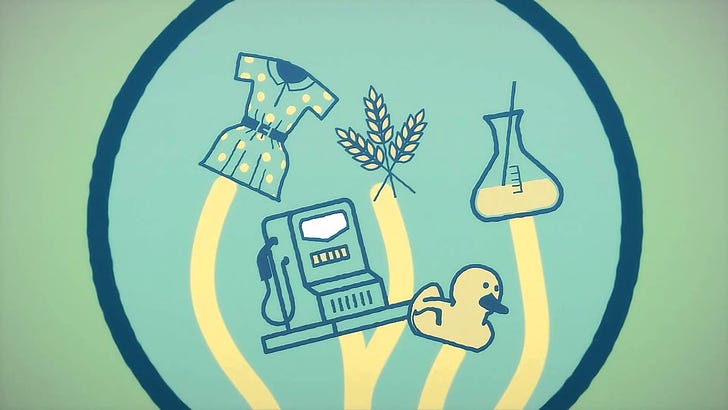Beyond Energy: Why We Need a Consumption Transition to Decarbonize
Sequestering Carbon, Sparing Animals: The Dual Climate Opportunity of Animal-Free Biotech
Today, I will try to make a compelling case for why we need to go beyond just energy transition and also focus on transitioning how we consume and manufacture products.
This post combines facts, rants, and optimism. We hear so much about alternative protein investments drying up, and my gut response is "SCARY"—scary for the world, investors, and consumers alike. We hear plenty about energy transition at climate conferences, but we barely discuss the potential for decarbonization with biotech and bioeconomy solutions. This requires shifts in how we manufacture and produce what we eat, wear, and take as medicines.
Our reliance on Mother Nature is enormous. Animals work for us day and night, yet in return, they get abused. We take away their lives, their children, and their very existence. We're unsure how long we can sustain this extractive approach, especially the taking of sentient lives. We still view nature-based solutions and solar/wind farms as the main decarbonization methods. But we don't hear much about novel bioeconomy ways to reimagine what and how we consume that could drastically affect climate change. We also need to change what we manufacture and how.
We still see basic nature-based solutions and solar/wind farms as decarbonization methods. We don’t hear much about novel bioeconomy ways of how we consume and what we consume that can drastically affect climate change. We also need to change how we manufacture and what we manufacture.
The global decarbonization market is expected to grow at a CAGR of 11.5% from 2023 to 2032, reaching $2.54 trillion by 2032.1
Is there a better manufacturing method that's less extractive, cleaner, and kinder to Mother Nature?
We don’t JUST need energy transition; we need consumption transition.
The global economy's reliance on animals significantly contributes to greenhouse gas emissions and climate change. Livestock farming alone accounts for around 14.5% of global human-induced emissions. By removing our reliance on animals and transitioning to animal-free alternatives, we can drastically reduce our carbon footprint and accelerate economic decarbonization.
Animal-free food, materials, and ingredients have substantially lower carbon, land, and water footprints than animal-derived counterparts. For example, animal-free meat and dairy products can reduce emissions by 30-90%. Similarly, natural, animal-free ingredients in cosmetics have a much smaller environmental impact.
Investing in solutions like YeastUp, which uses upcycled protein from spent brewer yeast, Algama, which uses protein/ingredients from microalgae (which act as an excellent way for carbon capture23), and Ingrediome, which uses precision fermentation using cyanobacteria (blue-green algae are great carbon sinks4), can supercharge decarbonization. These circular solutions leverage organisms that actively remove carbon, creating a double climate benefit. These novel solutions leverage circularity and utilize organisms that can actively sequester carbon, creating a double benefit for the climate.
Let us talk some more numbers.»
Plant-based and lab-grown meat alternatives have the potential to partially replace traditional livestock farming, which is a significant contributor to global greenhouse gas emissions. Livestock production accounts for approximately 7.1 gigatonnes of carbon dioxide equivalent per year, producing 14.5% of total anthropogenic (human-caused) greenhouse gas emissions worldwide2.
Enhancing current forestry and agricultural practices could increase carbon sequestration (the process of capturing and storing atmospheric carbon dioxide) by approximately 25%. Improved methods in these sectors have the potential to augment the natural removal of carbon dioxide from the atmosphere34.
Carbon capture through genetically engineered crop plants presents a promising economic opportunity. For instance, sugarcane could be genetically modified to produce substantial quantities of biodiesel, with a projected yield of around 6,700 liters per hectare—significantly higher than the yield of soybeans, which is approximately 500 liters per hectare.5
Decoupling from animals also opens up opportunities to utilize more sustainable agricultural practices that sequester carbon, improve soil health, and support biodiversity. This shift from industrial animal agriculture can be crucial in meeting global climate targets and building a more sustainable, low-carbon future. Accelerating this transition is essential for rapidly decarbonizing our economies and societies.
That is where we at Beyond Impact give an alternative to climate financing. A way to decarbonize is by changing the way we consume and how we consume. The animal-free economy provides a great alternative. We are at the cusp of a generational shift to decarbonize every aspect of our existence - cleaner, healthier, and kinder to the people, planet, and animals.
Additional resources for further curiosity.»
Biotechnology for carbon capture and fixation: Critical review and future directions, ScienceDirect
The potential of CO2-based production cycles in biotechnology to fight the climate crisis, Nature
Designing for deep decarbonization: accelerating the US Bioeconomy
Sustainable and circular bio-economy in the climate agenda, FAO
The Bioeconomy to the Rescue by Gordon Rausser and David Zilberman
Sign-off for humanity,
Sagar Tandon
Follow me on LinkedIn» https://www.linkedin.com/in/sagartandon/
Mail me at » sagar@beyondimpact.vc
Stay humble, stay curious 🌟🌟🌟!
Note: These are my personal opinion.
If you have not subscribed, please do subscribe to keep up to date with my musings on venture capital, venture building, impact investing, conscious capitalism, and fund management.
Gerber, P. J. & Food and Agriculture Organization of the United Nations. Tackling Climate Change Through Livestock: A Global Assessment Of Emissions And Mitigation Opportunities. 141 (Food & Agriculture Organization, 2014).
Smith, P. et al. Agriculture, forestry, and other land use (AFOLU). In Climate Change 2014: Mitigation of Climate Change. Contribution of Working Group III to the Fifth Assessment Report of the Intergovernmental Panel on Climate Change (eds. Edenhofer, O. et al.) (Cambridge University Press, 2014).
Sutton, M. A. et al. Nitrogen - Grasping the Challenge. A Manifesto for Science-in-Action through the International Nitrogen Management System.Summary Report. Centre for Ecology & Hydrology, Edinburgh, UK (2019).
Huang, H., Long, S. & Singh, V. Techno-economic analysis of biodiesel and ethanol coproduction from lipid-producing sugarcane. Biofuels, Bioprod. Bioref. 10, 299–315 (2016).




